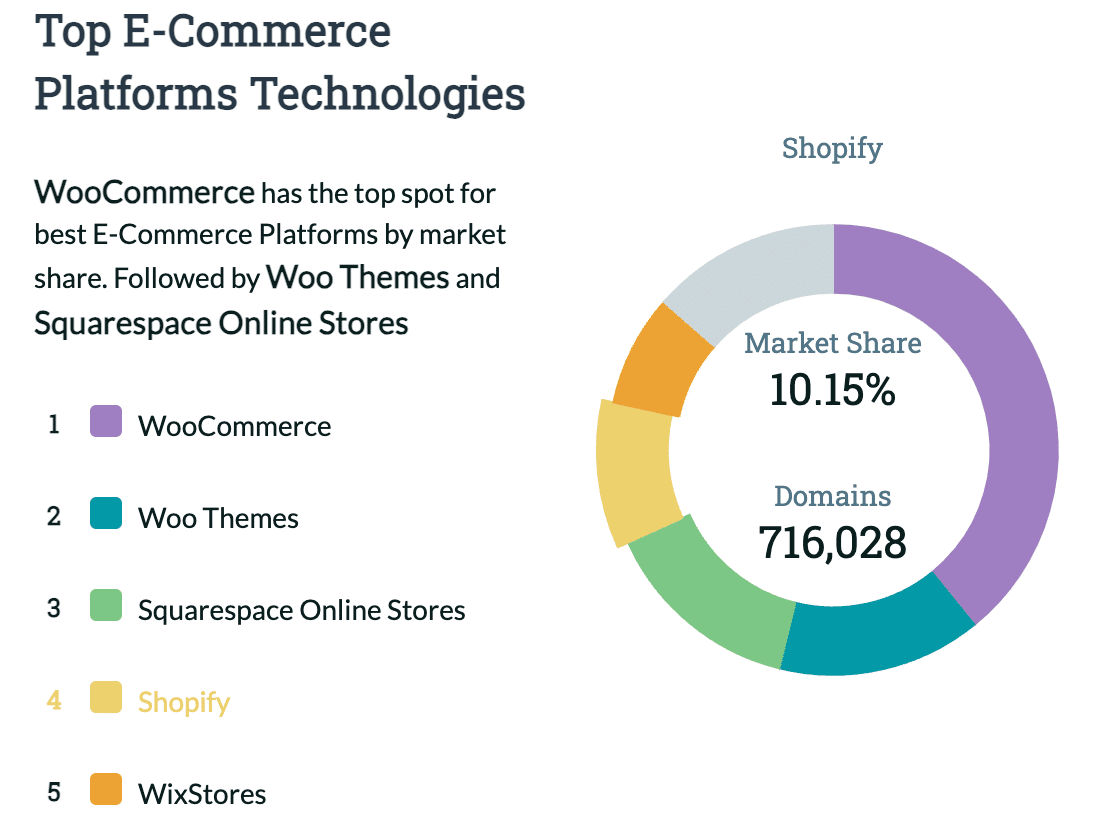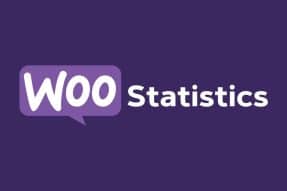Shopify Statistics (How Many Websites Use Shopify?)
Shopify is one of the most popular ecommerce platforms on the market and powers more stores than any other ecommerce solution.
This post look at some super interesting Shopify statistics that tell us more about this powerful, cloud-based SaaS platform and its merchants.
We’ll reveal the number of websites and merchants that use Shopify and deeply dive into all the most important data about the platform’s market share, revenue, apps, themes, and more.
Ready? Let’s get started!
Shopify statistics (top picks)
- There are over 3.9 million Shopify websites, and over 2 million Shopify merchants
- 65% of Shopify domains are registered in the US
- Shopify is the #1 most popular ecommerce solution and the #2 most popular CMS after WordPress.
- Shopify earned over 4.6 billion in revenue in 2021, and most of that came from its merchant solutions
- Shopify’s GMV was over 175 billion last year (that’s the total value of merchandise sold through Shopify stores)
- There are over 15 million Shopify orders each month
- Clothing is the most popular product category sold through Shopify stores
- The average Shopify order value is $75
- The average Shopify conversion rate is 1.4%
- There are over 8,000 apps in the Shopify App Store, and the Product Reviews app is the most popular
- There are 102 themes in the Shopify Theme Store, and Dawn is the most popular
How many websites use Shopify?
There are currently over 3.9 million live websites that use Shopify. Almost two-thirds of these website domains (65%) are registered in the US, and the vast majority are registered in countries in North America and Europe.
Number of Shopify websites by country
- US – 2.6m
- UK – 170k
- Australia – 122k
- Canada – 99k
- Germany – 94k
- Brazil – 76k
- France – 54k
- India – 39k
- Netherlands – 36k
- Italy – 32k
Sources: BuiltWith
Shopify market share
Shopify’s CMS market share is 6.1%, making it the second most popular CMS after WordPress. And it’s ecommerce market share is 10% to 22%, depending on which data source you look at.
What percentage of websites are built on Shopify?
4.1% of all websites on the internet are built on Shopify, according to data from W3Tech. This climbs to 6.1% if we only count websites that have content management systems that W3Tech monitors.

This makes Shopify the second most used content management system. However, it’s still a long way behind WordPress, which dominates the market with over 43% of the market share.
This is likely due to the fact that Shopify is exclusively designed for ecommerce stores, whereas WordPress is a general-purpose CMS that powers all types of websites.
What percentage of ecommerce stores use Shopify?
Shopify’s ecommerce market share varies depending on which source you look at.
According to BuiltWith, 22% of ecommerce stores use Shopify, making it the #1 most popular ecommerce solution. That’s slightly more than the market share of both WooCommerce and Wix stores; each of which powers around 20% of ecommerce stores.
However, Datanyze puts Shopify’s ecommerce market share substantially lower. According to their data set, Shopify is used on around 716k domains, giving it a 10.15% market share. This puts it behind both WooCommerce and Squarespace.

BuiltWith’s figures are likely the most accurate of the two, based on a larger data set.
Sources: BuiltWith, W3Techs, Datanyze
How many Shopify merchants are there?
There were 2.06 million Shopify merchants at the end of 2021. Note that this is substantially lower than the total number of Shopify stores online, which suggests many Shopify merchants have multiple stores.
Number of Shopify merchants by region
Shopify merchants are distributed across 175 different countries, but over half are from North America (NA). Merchants in NA also bring in over two-thirds of Shopify revenues.
The graph below shows a breakdown of merchants and revenues by region:
| Region | Merchants (% of total) | Revenues (% of total) |
| North America (US and Canada) | 55% | 71% |
| EMEA (Europe, Middle East, and Africa) | 25% | 17% |
| APAC (Asia Pacific, Australia, and China) | 15% | 10% |
| Latin America (Mexico and South America) | 5% | 1% |
What is the most popular Shopify plan?
The vast majority of Shopify merchants are on subscription plans that cost <$50/month (i.e. Basic or Shopify plans)
Interestingly, only 14,000 merchants are subscribed to Shopify Plus plans—the highest-tier plan. This is only a tiny fraction of the overall Shopify user base. And yet, Shopify Plus merchants drive the majority of Shopify’s total GMV (general merchandise value).
Source: Shopify Annual Report 2021, Shopify Year In Review 2021
Shopify financial statistics
Next, let’s take a look at some financial statistics per Shopify’s latest annual reports and quarterly earnings press releases.
Shopify income
Shopify generated a net income of over 2.9 billion in 2021. This was one of its best years to date.
Comparatively, net income in 2020 was just 319.5 million. And for the three years prior, Shopify reported a net loss. These losses were largely a result of Shopify’s hefty investments in growing the business.
Shopify net income by year:
- 2021: 2.9 billion
- 2020: 0.32 billion
- 2019: -0.12 billion
- 2018: -0.065 billion
- 2017: -0.040 billion
Shopify profit
Shopify reported gross profits of 2.48 billion in 2021. This is almost a billion dollars more than the year before when annual gross profits were just 1.5 billion.
And it looks like Shopify is on track to have an even better year this year. By the end of the third quarter of 2022, Shopify had earned 1.96b in gross profit. That’s a significant year-over-year increase—by the end of Q3 2021, gross profits were just 1.79b.
Shopify revenue
Shopify reported gross revenues of over 4.6 billion in 2021. That’s up by 57.4% compared to the year before when it was just 2.9 billion.
But again, it looks like 2022 is going to be an even better year for Shopify with the highest revenues yet. By the end of Q3 2022, Shopify had earned 3.86b in revenue, compared to just 3.23b by the same time in 2021.
Shopify revenues by location
The vast majority of revenue Shopify generated in 2021 came from customers in North America (71%), with the US alone responsible for 64.5% of revenue. In comparison, Latin America contributed just 1.2% to Shopify’s annual revenue.
| Region | Revenue (USD) | Revenue (% of total) |
| US | 2.96 billion | 64.5% |
| Canada | 317 million | 6.9% |
| EMEA | 799 million | 17.3% |
| APAC | 467 million | 10.1% |
| Latin America | 55 million | 1.2% |
Where does Shopify’s revenue come from?
The vast majority of Shopify’s revenue comes from its merchant solutions:
- In 2021, Shopify earned 1.34 billion (29.1% of its total annual revenue) from its subscription solutions…
- …and 3.27 billion (70.9% of its total annual revenue) from its merchant solutions
Subscription solutions refer to revenue Shopify makes from selling recurring subscription plans to its merchants (i.e. Basic, Shopify, and Shopify Plus).
But while these plans may seem like Shopify’s main service offering, they’re only responsible for less than a third of Shopify’s revenue.
Merchant solutions refer to revenue generated through other sources. The bulk of merchant solution revenues comes from payment processing fees and currency conversion fees on merchant sales processed through Shopify Payments—Shopify’s in-house payment gateway.
This shows just how important Shopify Payments is to the platform’s business model. It also explains why Shopify—unlike some competitor ecommerce platforms—charges additional transaction fees when merchants choose to use other third-party payment gateways instead of Shopify Payments.
Aside from Shopify Payments fees, merchant solutions also include revenue derived from things like referral fees, advertising revenue, Shopify Email, etc.
It’s interesting to note that Shopify’s merchant solution revenues are tightly correlated with GMV (the total number of sales made by Shopify merchants). The more Shopify merchants make, the more Shopify makes in fees. This provides a strong incentive for Shopify to invest in its merchants’ success.
Shopify Payments usage
The Shopify Payments penetration rate was 48.9% in 2021.
This means that over half of all Shopify merchants use the in-house payment gateway. However, this likely underrepresents Shopify Payments’ true adoption rate as it’s not yet available in all the countries where Shopify is used.
In regions where Shopify Payments is available, over four-fifths of merchants use it:
Usage of Shopify Payments by region:
- Canada – 92%
- US – 88%
- Other countries where it’s available – 84%
Almost $86 billion in GMV was processed using Shopify Payments in 2021.
Sources: Shopify Annual Report 2021, Q3 Earnings Press Release
Shopify sales statistics
Shopify merchants collectively made over $175.4 billion in 2021 alone. And in total, over $500 billion worth of sales have been processed through the Shopify platform since its launch.
Shopify GMV (growth merchandise volume)
Shopify’s GMV (gross merchandise volume) has grown year over year. It increased by 46.7% in 2021 alone, growing from 119.6 billion to 175.4 billion. This rapid growth was no doubt accelerated by the shift to ecommerce brought around by the global COVID pandemic.
In case you didn’t know, GMV is a figure that tells you the value of merchandise sold over time. Or in other words, the total sales revenue generated by all the stores that use Shopify.
Shopify GMV by year:
- 2021 – 175.4 billion
- 2020 – 119.6 billion
- 2019 – 61.1 billion
- 2018 – 41.1 billion
- 2017 – 26.3 billion
- 2016 – 15.4 billion
- 2015 – 7.7 billion
- 2014 – 3.8 billion
- 2013 – 1.6 billion
- 2012 – 0.7 billion
How many people buy from Shopify merchants?
Over 597 million people bought from Shopify merchants this year. That’s up from 457 million shoppers in 2021 (+31% YOY), and from 300 million shoppers in 2020 (+52% YOY). To put that into perspective, 597 million people is almost double the population of the United States.
How many Shopify orders are placed each month?
Shopify processed 152.6 million orders per month on average in 2021. And interestingly, 66% of these orders come from mobile devices, which shows the importance of making sure your store and product pages are mobile-responsive.
What month do most Shopify sales take place in?
Data shows that Shopify stores experience more sales in November than any other month. This is likely because November is the month of large sales events like Black Friday and Cyber Monday. It’s also the month many consumers start buying gifts before the holiday season.
On the other end of the spectrum, Shopify stores experience the least sales in February than any other month. This is likely because February immediately follows two of the most popular shopping months: December and January.
How much traffic do Shopify stores get?
Shopify stores averaged 7.1 billion monthly browsing sessions in 2021 (mostly from mobile). That’s almost equal to the global population (7.9 billion) and highlights just how big the online shopping market is.
Sources: Shopify Annual Report 2021, Shopify News, Shopify Year In Review 2021
What is the best product to sell on Shopify?
According to an analysis of 2.8 million products on Shopify shops, clothing is the most popular product category sold through Shopify. Over 75 thousand Shopify stores in the sample analyzed sell clothing products. This was more than double the next most popular product category, Home & Garden.
However, while this statistic shows that clothing is the best-selling product category, it doesn’t mean it’s the best choice for your store. You might be better off choosing a less-popular, niche product category with less competition.
Top 10 best-selling product categories on Shopify
- Clothing – 75.5k
- Home & Garden – 33.8k
- Jewelry & Watchers – 27.6k
- Health & Beauty – 24.7k
- Fashion Accessories – 22.9k
- Food & Beverages – 16.3k
- Art – 11.6k
- Sporting Goods – 7.7k
- Electronics – 6.9k
- Car & Truck Parts – 6.2k
(Other – 66k)
Source: Statista1
Shopify benchmarks
Next, let’s look at some Shopify statistics that reveal useful benchmarks that you can measure your own store’s metrics and KPIs up against.
What’s the average Shopify order value?
The average online order in Shopify stores is $75. However, there’s significant variation from order to order. If you’re selling high-ticket products, your order value will likely be much higher, whereas if you’re selling low-cost products like phone cases, it may be much lower.
What’s the average Shopify store conversion rate?
The average Shopify conversion rate is 1.4%, according to Littledata’s survey of 3,223 Shopify stores (the best data to date). This is slightly higher than the average conversion rate across all ecommerce stores, which is 1.3%, and a good benchmark to aim for.
But again, there’s significant variation between stores. The top 20% of Shopify stores boast conversion rates of over 3.2%, and the top 10% reach 4.7%+. Meanwhile, the bottom 20% of Shopify stores have conversion rates of 0.4% or less.
How often do people buy from Shopify stores?
On average, shoppers buy from the same store 3.8 times. And over half of all Shopify merchants see buyers make purchases from their store 2 or more times.
In 2021, over 62 million online shoppers bought from the same Shopify store twice. This is 14% of all shoppers.
Source: Shopify News, LittleData
Shopify app statistics
How many Shopify apps are there?
There are over 8,000+ apps in the App Store, with more added monthly. This huge repository of third-party add-ons is part of the reason Shopify is so popular—it’s almost infinitely extensible and flexible.
What’s the most popular Shopify app?
According to an analysis by Store Leads, product Reviews is the most popular Shopify app. It’s installed on at least 405,000 Shopify stores. The second most popular app is Shopify inbox, with over 262,000 installations.
Top 10 most used Shopify apps (by installations):
- Product Reviews – 405k
- Shopify Inbox – 262k
- Klaviyo – 248k
- Geolocation – 219k
- Customer Privacy – 193k
- Mailchimp – 161k
- Judge.me – 144k
- Loox – 138k
- DSers – 127k
- Printful – 125k
Sources: Shopify News, Store Leads
Shopify theme statistics
How many Shopify themes are there?
There are 102 themes in the Shopify Theme Store at the time of writing, and many more on third-party websites. For example, 1,500 Shopify themes and templates are listed on Theme Forest.
Of the 102 native Shopify themes, only 9 are free. The other 92 are paid themes that cost anywhere from $200 to $350 each.
What’s the most popular Shopify theme?
The most popular theme in Shopify’s free collection is Dawn, and the most popular paid theme is Impulse. The best-selling Shopify theme on Theme Forest is Ella, with 28.3k sales to date.
Top 10 most popular Shopify themes (in the Shopify Theme Store):
- Dawn
- Craft
- Refresh
- Sense
- Ride
- Studio
- Taste
- Crave
- Colorblock
- Impulse
Source: Shopify Theme Store, Theme Forest
When was Shopify founded?
Shopify was in 2006, making it one of the oldest ecommerce solutions. 2022 marked Shopify’s 16th birthday.
Who founded Shopify?
Shopify was founded by Tobias Lutke and Scott Lake
Lutke was a computer programmer who decided to use the open-source framework Ruby on Rails to build his own ecommerce store (Snowdevil) to sell snowboarding equipment, after deciding he was dissatisfied with existing e-commerce products.
Later, Lutke and Lake decided to launch the platform as Shopify. They then created an open-source template language called Liquid.
Source: Shopify News, Shopify Annual Report 2021, Wikipedia
General Shopify facts & statistics
Before we wrap up, let’s look at a few more interesting facts and stats about Shopify.
How many employees does Shopify have?
Shopify has over 10,000 employees in 2022. This is up from 7k at the end of 2021
How many countries is Shopify available in?
Shopify is available in 175 of the 195 countries on earth. However, certain features are only available in select countries. For example, Shopify Payments is only supported in 22 of the 175 countries that Shopify is available in.
Misc. interesting Shopify statistics
- Shopify enabled 307b in global economic activity in 2021
- The Shopify platform can handle at least 540,000 per second, and 27,000 orders per minute. Uses a technology called ‘containerization’ to do this.
- Median response time is sub-1000 milliseconds for Shopify stores in 2021
- 40,000 of the partners in Shopify’s partner ecosystem (app developers, theme designers, marketers, affiliates, etc) referred merchants to Shopify in 2021
- 30% of Shopify merchants say marketing is one of their biggest challenges, making this the #1 challenge Shopify store owners face. Building a brand is the second biggest challenge at 22%
- 100k+ retailers used Shopify POS to sell in-person in 2019
- According to a global analysis of Shopify stores in 2021, around 7.8% use third-party dropshipping services like Oberlo. That means the vast majority are not dropshipping stores.
Source: Shopify News, Shopify Annual Report 2021, Shopify Payments, Shopify Year In Review 2021, Statista2
Final thoughts
That concludes our roundup of Shopify statistics. We hope you learned something useful.
Want to share these statistics or use them in your own content? Don’t forget to drop a link to this post!
And while you’re here, if you found these statistics useful, you might want to check out some of our other stats roundups:
- Check out these WordPress statistics to learn how Shopify stacks up against one of its biggest competitors.
- And to brush up on the state of the web design industry in general, take a look at our roundup of the latest web design statistics.
Enjoy!







This Post Has 0 Comments